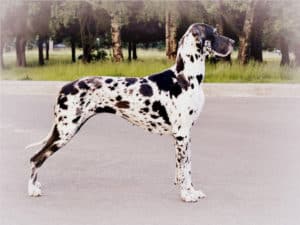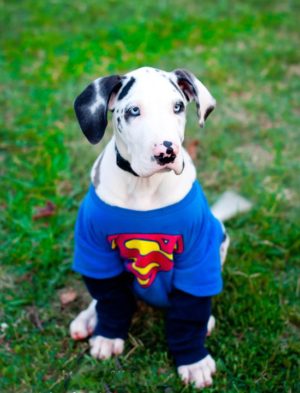If you’ve ever watched the game show “The Price is Right”, you’ve certainly heard the call at the end of the program to have your pet spayed or neutered. But…
Should you neuter your Great Dane? What are the Pros and Cons? An overwhelming majority of canine experts highly recommend having your Great Dane (or any dog) neutered. However, those who oppose neutering make some valid points. This article will cover all the facets that pertain to neutering.
Today we’re going to talk about 5 of the pros and cons of neutering your Great Dane dog so you can make an informed decision and the BEST decision for your furry companion.
In This Article You’ll Discover:
- What Neutering Your Great Dane Entails & the Risks Involved
- What Neutering Your Dog Won’t (or will!) “DO”
- 5 Pros and Cons of Neutering Your Great Dane
- When to Neuter Your Great Dane
- What to Expect After Surgery
*Please Note: This article contains the most accurate and up-to-date information available in one convenient location. You’ll find the sources referenced at the conclusion.
Whether you decide you neuter your four-legged companion is a personal choice only you can make. The more information you have at your disposal, the easier it will be for you to make the choice that’s best for YOUR Great Dane dog. I know at the end of the day, that’s exactly what we want for our beloved pet(s)!
Let’s take a look at the top 5 FAQs that pertain to having a Great Dane dog neutered, sort facts from opinions about what you can expect if you have him neutered (or don’t) and find out once and for all what the experts in dog health and well-being have to say.
What Does Dog Neutering Entail?
We know that neutering a Great Dane is the way to absolutely avoid him becoming a sire of whelps (young pups) but do you know what the surgery entails? It’s pretty straight forward, and another like it used to be…
There was a day when neutering a male dog was done in some very unpleasant ways 🙁
We won’t even get into THAT topic!
Thankfully, today, having your Great Dane neutered is considered a “minimally invasive procedure”. In most cases, you will drop your dog off early in the morning, and he will be ready to come home by evening. Here’s what will happen in between:
How a Great Dane is Neutered in 5 Steps:
- He will be first prepped for surgery by being cleaned, possibly shaved, and likely medicated.
- Your dog will be placed under general anesthesia.
- An incision will be made in front of the scrotal sac and both testicles will be cut out with a scalpel, leaving the sac intact.
- The incision will be stitched and (depending on the surgeon) bandaged.
- Your Great Dane will be monitored as he wakes from the anesthesia and observed until he is picked up at the pre-arranged time.
FYI: You can expect your Great Dane to fully heal from being neutered in 2-4 weeks.

Risks to Neutering Great Danes
There are risks to any medical procedure that involves cutting the skin to every creature on this planet that has skin. We weigh the benefit of the procedure against the risks and make medical decisions accordingly. The medical risks associated with neutering your Great Dane dog include:
- Infection
- Allergic Reaction
- Thyroid Issues
- Certain Cancers Developing
I’ll address each of these risks a little further along in this article.
Does Neutering Lessen Male Canine Aggression?
Aggression is a behavior in dogs fueled by testosterone, the hormone that causes your Great Dane to act like a…well…male dog. Having him neutered will affect his hormone levels, definitely lowering the amount of testosterone coursing through his veins. The result? Lower aggression levels.
Dogs with more serious aggression issues may continue to exhibit undesirable behaviors after surgery. This situation warrants a discussion with the dog’s veterinarian or perhaps even a Canine Behavioral Specialist. Great Danes are smart! This makes them susceptible to loneliness, boredom, and even anxiety! Any of these issues could manifest as aggression, and the owner should strive to address the root of the issue.
Will Neutering a Great Dane Stop “Spraying”?
Most owners of neutered dogs do report a decrease in “spraying” activity. Really, though, it depends on the motive behind the behavior. Most males do spay to announce their masculine presence, and when those testosterone levels drop, so will the behavior.
However, other males spray for reasons such as stress or anxiety. If your Great Dane was spraying for those reasons, the behavior may continue. In either case, spraying may also be a habit the dog has formed, and the spraying may continue after neutering surgery.
Will Neutering a Great Dane Make Him Fat?
Statistics show a neutered dog can pack on pounds, and statistics don’t lie, right?!? BUT, there’s always a “but”, isn’t there?!? Being neutered isn’t what can pack on the pounds! A neutered dog’s human not adjusting his diet and exercise regime after surgery is how those extra pounds can creep up, and those extra pounds aren’t healthy!
A responsible pet owner (a goal I know we all keep forefront in our mind) will observe any changes in a dog’s activity level after being neutered and recalculate the dog’s caloric and exercise needs.
Learn more about how much exercise your Great Dane needs by clicking right here. You’ll be redirected to an informative article here in the Big Dog Den.
What do Experts Have to say About Neutering Your Great Dane?
According to Dr. Christine Newman: Harlingen Veterinary Clinic…
One of the best things you can do for your Dane is to have her spayed (neutered for males). In females, this means we surgically remove the ovaries and usually the uterus, and in males, it means we surgically remove the testicles. Spaying or neutering decreases the likelihood of certain types of cancers and eliminates the possibility of your pet becoming pregnant or fathering unwanted puppies. Performing this surgery also gives us a chance, while your pet is under anesthesia, to identify and address some of the diseases your dog is likely to develop.
For example, if your pet needs hip X-rays or a puppy tooth extracted, this would be a good time—it’s more convenient for you and easier on your friend too. Routine blood testing prior to surgery also helps us to identify and take precautions against common problems that increase anesthetic or surgical risk. Don’t worry; we’ll discuss the specific problems we will be looking for when the time arrives.

5 Pros & Cons of Neutering Your Great Dane
PRO 1: Neutering Combats Certain Cancers
Male dogs are susceptible to developing Prostate Cancer in their senior years. Unless detected and treated early, Prostate Cancer will be fatal to your Great Dane. Neutering him will decrease the risk of this certain cancer developing.
CON 1: Surgery/Anesthesia/Recovery Risks
Anytime your Great Dane’s skin is cut open, he is immediately at risk for an infection. Although the veterinary clinic is sterile and precautions against infection are implemented, the infection risk is only reduced and not eliminated.
Anesthesia is another area of concern. Your dog will receive general anesthesia for the neutering procedure, essentially assigning all his life-support to machines that will do his breathing and circulate his blood. An allergic reaction to the anesthesia is a critical situation that can instantly turn fatal.
PRO 2: Neutering Lowers Risk of Prostate Disease
The most common prostate issue dogs encounter as they age is Benign Prostatic Hypertrophy (or Hyperplasia), (BPH). Neutered males have a lower chance of developing BPH by over 33%.
CON 2: Increased Chance of Obesity
If you didn’t think your Great Dane could get any lazier, have him neutered! Owners of Great Danes report that their already inactive dog became even more inactive after being neutered and began packing on pounds!
Obesity brings on its own set of health problems and must be avoided. Be sure that your Great Dane dog (neutered or not) is getting about an hour a day of exercise, broken down into 2 or 3 increments. Don’t forget to allow for some “off-the-leash frolicking, if possible, weekly if not daily.
Additionally, feed your Great Dane a diet formulated for large breed dogs, and has a primary source of protein (preferably meat) listed as its first ingredient. To learn more about the different dog food formulas, you won’t want to miss this article, right here in the Big Dog Den.
PRO 3: Neutering Eliminates Unwanted Pups
Did you know that in the United States alone, 670,000 dogs are euthanized annually simply for not being wanted? Neutering males and spaying females is the only absolute solution to this tragic loss of canine lives for such a flippant reason.
Should you decide not to neuter your Great Dane, I have no judgment against you, but would be remiss not to urge you to carefully plan any litters of puppies that may be in your dog’s future.
CON 3: Neutering will Make Your Dog Look…Ahem…Different
Your male Great Dane has anatomy that clearly announces the “maleness” about him. When he comes back from being neutered, quite frankly, he will come back without his scrotum. If this visual difference is unsettling to you, discuss the issue with your dog’s veterinarian. You may want to find other ways to keep your dog healthy and unable to sire puppies.
PRO 4: Neutering May Calm the Urge to Roam
A 6-foot fence is generally accepted as a formidable barrier between your Great Dane and the “outside world”. However, if your Great Dane is male, and a female is in heat in the vicinity, he’ll scale that fence in a heartbeat as if it weren’t even there!
And heck, who am I kidding? A squirrel can have the same effect on your dog’s determination to scale that fence, LOL! Some dogs are just “Houdinis”… fixated on escaping any confines you impose.
Whatever the reason your dog may escape to roam, being neutered will curb the desire, essentially curbing the dog. The reduced levels of testosterone his body will produce will reduce or remove the behaviors associated with that testosterone, like roaming.
CON 4: Neutering Increases the Risk of Hemangiosarcoma
So yes, neutering your Great Dane will reduce (or eliminate) the risk for a certain kind of cancer and increase the risk for another. Sigh. It’s a “weigh the risks” kind of a gamble. Hemangiosarcoma is almost an exclusive disease of dogs. Tumors are formed by the cells that normally create blood vessels. When the same thing happens in humans, it’s called Angiosarcoma.
The reproductive hormones (in this case, testosterone) help to keep the risk of developing Hemangiosarcoma low.
PRO 5: Neutering Makes for a Well-Rounded Temperament
I understand that the terms “pro and con” can both be relative. I do. Some Great Danes will head into surgery with some “rough edges”. A dog doesn’t have to be aggressive to exhibit tendencies that are spawned from the aggression center in the brain. Being “pushy” is one of these behaviors, as well as excessive barking or chewing.
There’s a very good chance that your Great Dane will come home from his neutering surgery with any of these types of behaviors greatly reduced, or even eliminated!
Surely, you will not consider this a pro if you enjoy your dog being on the “sassy” side. Many dog owners do enjoy a feisty pet. Neutering will take that “feisty” down a notch, and the difference will be noticeable.
CON 5: Neutering Triples the Risk of Hypothyroidism
Your Great Dane’s thyroid does the same thing the thyroid in your body does. The thyroid is the epicenter for hormone balance. Hormones control metabolism, aggression, sexuality, and the body’s overall temperament. Hypothyroidism means the thyroid is underperforming and your dog’s health and well-being will suffer for it.
If you decide to have your Great Dane neutered, please discuss the subject of Hypothyroidism with the veterinarian, and plan a course of action to avoid the condition altogether, or efficiently treat it.

When Should You Neuter a Great Dane?
The generally accepted age for a dog to be neutered is between 6 and 9 months. These days, though, more and more breeders, shelters and kennels are neutering pups as early as 8 weeks old. This is not necessarily a good idea, though, and this author’s research indicates that neutering too early in a dog’s life can be detrimental to his overall health and longevity.
After reading the evidence alone, with all opinions aside, I can only recommend you wait to have your Great Dane neutered until he has reached his first birthday. There’s work that testosterone needs to do before we start altering its levels. Dogs that are neutered too soon can keep the “gangly” look of their adolescence into adulthood instead of forming mature and fully-developed muscles.
Post Neuter Great Dane Care
When you pick your dog up from the surgery center, you can expect him to not be his usual chipper self. He will likely be a little frightened, a little groggy, and a little bit sore. For the first week after his neutering, you can best help your dog’s recovery in the following ways:
- Keep your Great Dane’s activities to a minimum. Limit distance walked for potty breaks, and keep the food and water bowls next to your dog’s sleeping area.
- Check his incision twice daily to be sure it’s clean and dry, and that infection is not developing above or below the skin. Signs of infection include swelling, redness, the incision oozing pus (or pus-y blood), and the area around the incision being hot to the touch.
- Observe your dog’s pain levels. Your dog began “speaking” to ou with his body language the day he arrived at your home. If you’ve been observant, it will be easy for you to notice when your dog is in pain, and when he begins feeling better. Recovering from being neutered should be a general progression from your dog ailing to him feeling more like himself again in about 2 weeks or so. If you’re not seeing progress to indicate he is, indeed, on the mend, schedule an appointment for his veterinarian to examine him.
I should note that your dog may experience some nausea and/or diarrhea from the anesthesia and even from the medication the veterinarian will likely prescribe to prevent infection.
5 Remedies for Your Great Dane’s Upset Stomach or diarrhea:
- A 24 HOUR FAST: Yes, a fast. Sometimes the best way to calm a tummy is to let it stand empty for a day. You will likely see a decrease in appetite in your Great Dane (yes, really, LOL!) for the first few days after surgery anyway.
- CANNED PUMPKIN: Mix canned pure pumpkin into his regular food. Do NOT use pumpkin pie filling! Pure pumpkin contains dietary fiber that soothes the digestive tract and absorbs moisture from the stool. Use 2-4 tablespoons per meal.
- OATMEAL: Cook some oatmeal. Do NOT use the flavored kind in a packet, use real whole oats or quick cook oats. Let it cool off. Mix 1-2 cups into your dog’s regular food.
- COTTAGE CHEESE OR YOGURT: A spoonful or two (or more for bigger dogs) of cottage cheese or plain yogurt in his food can also be beneficial for firming stool without causing constipation if your Great Dane has already shown he tolerates dairy products well.
- BLAND FOOD: Cooked chicken or rice or both, plain with no seasoning added. You can add it to your dog’s regular food, or just feed him the chicken and rice.
Every time your Great Dane moves his bowels for the first few days after surgery, you must look at it for color, consistency, and to be sure there isn’t any blood or mucus present in the stool. This is so important!
If diarrhea doesn’t clear within 48 hours, you could try Kaopectate, an over-the-counter kaolin/pectin product, according to his weight.
If diarrhea hasn’t slowed and his stool hasn’t firmed up in 72 hours, or if there is any sign of blood or mucus in the stool, consult your veterinarian for sure.

I’m confident in knowing you’re armed with the best information possible and know if, how, and when you will have your Great Dane dog neutered. I wish you both the best outcome in whichever decision you make and invite you to drop by the Big Dog Den often to answer the unique questions owning a big-breed dog can raise… our library is massive and ever-growing! Simply type “Great Dane” into the Big Dog Den’s convenient search bar to discover a plethora of useful information! See you soon, and I wish you good health. 🙂
- Sources Cited:
- The American Veterinary Medical Association (AVMA)
- The Great Dane Club of America (GDCA)
- The American Kennel Club (AKC)
- People for the Ethical Treatment of Animals (PETA)
- The American Society for the Prevention of Cruelty to Animals (ASPCA)
*This article has been reviewed in accordance with our editorial policy.
Harlingen Veterinary Clinic
Dr. Christine Newman
